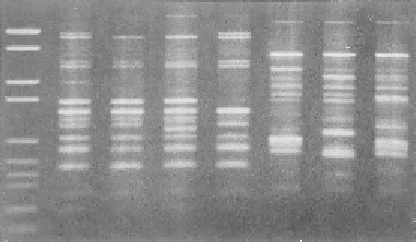Biology Reference
In-Depth Information
1
2
3
4
5
6
7
8
2176
1766
1230
1033
653
517
453
394
298
234
Figure 13.2
RAPD-PCR banding patterns obtained from individual
Trioxys pallidus
male wasps (lanes
2-5) and individual
Diglyphus begini
males (lanes 6-8) provide clear species differences. Size stan-
dards are in lane 1 for reference. (Photograph provided by O. R. Edwards.)
(
Black et al. 1992, Kambhampati et al. 1992, Hadrys et al. 1993, Edwards and
Hoy 1995
).
RAPD-PCR has drawbacks. RAPD bands are inherited as dominant traits in
diplo-diploid species, thus heterozygotes normally cannot be identified. In
the haplo-diploid Hymenoptera, this difficulty is overcome by performing the
analysis on haploid males only, or by testing the genotype of females by test-
ing her male progeny (
Edwards and Hoy 1993
). RAPD-PCR conditions should
be optimized for each species (
Hadrys et al. 1992
). Reactions must be repeated
to determine which bands are “reliable” and consistent. RAPD-PCR is sensitive
to the concentration of template DNA in the reaction, so reaction conditions
must be optimized carefully and DNA extraction techniques must be consistent
(
Edwards and Hoy 1993
). Primer quality is critical; fresh, undegraded primers
should be used.
13.5.11 Sequencing
Sequencing provides large amounts of information about mtDNA and nuclear
DNA (
Thomas and Klaper 2004
). However, sequencing, because of time and
economic constraints, can sample only a tiny fraction of the total genome.
Also, despite reductions in the cost of sequencing, it remains more expensive
and time consuming than PCR-based methods. Sequencing of DNA amplified
by allele-specific PCR requires information about sequences to develop specific
primers. Sequencing has been used infrequently for large-scale population stud-
ies because of cost (
Table 13.1
), but it is a useful tool for other techniques, such
as developing allele-specific primers for the PCR. See Chapter 12 for methods of

